You didn't mention what data you're using, so we can't be sure that you're actually using the correct data, or even know what version of it you're using. The OWL ontology can be downloaded from the Lehigh University Benchmark (LUBM), where the OWL version of the ontology is univ-bench.owl.
Based on that data, you can use a query like this to find out how many OWL classes there are::
prefix owl: <http://www.w3.org/2002/07/owl#>
select (count(?class) as ?numClasses) where { ?class a owl:Class }
--------------
| numClasses |
==============
| 43 |
--------------
I'm not familiar with the Sesame workbench, so I'm not sure how it's counting types, but it's easy to see that different ways of counting types can lead to different results. For instance, if we only count the types of which there are instances, we only get six classes (and they're the OWL meta-classes, so this isn't particularly useful):
select distinct ?class where { ?x a ?class }
--------------------------
| class |
==========================
| owl:Class |
| owl:TransitiveProperty |
| owl:ObjectProperty |
| owl:Ontology |
| owl:DatatypeProperty |
| owl:Restriction |
--------------------------
Now, that's what happens if you're just querying on the ontology itself. The ontology only provides the definitions of the vocabulary that you might use to describe some actual situation. But where can you get descriptions of actual (or fictitious) situations? Note that at SWAT Projects - the Lehigh University Benchmark (LUBM) there's a link below the Ontology download:
Data Generator(UBA):
This tool generates syntetic OWL or DAML+OIL data
over the Univ-Bench ontology in the unit of a university. These data
are repeatable and customizable, by allowing user to specify seed for
random number generation, the number of universities, and the starting
index of the universities.
* What do the data look like?
If you follow the "what do the data look like" link, you'll get another link to an actual sample file,
That actually has some data in it. You can run a query like the following at sparql.org's query processor and get some useful results:
select ?individual ?class
from <http://swat.cse.lehigh.edu/projects/lubm/University0_0.owl>
where {
?individual a ?class
}
-------------------------------------------------------------------------------------------------------------------------------------------------------------
| individual | class |
=============================================================================================================================================================
| <http://www.Department0.University0.edu/AssociateProfessor9> | <http://www.lehigh.edu/~zhp2/2004/0401/univ-bench.owl#AssociateProfessor> |
| <http://www.Department0.University0.edu/GraduateStudent127> | <http://www.lehigh.edu/~zhp2/2004/0401/univ-bench.owl#GraduateStudent> |
| <http://www.Department0.University0.edu/UndergraduateStudent98> | <http://www.lehigh.edu/~zhp2/2004/0401/univ-bench.owl#UndergraduateStudent> |
| <http://www.Department0.University0.edu/UndergraduateStudent182> | <http://www.lehigh.edu/~zhp2/2004/0401/univ-bench.owl#UndergraduateStudent> |
| <http://www.Department0.University0.edu/GraduateStudent1> | <http://www.lehigh.edu/~zhp2/2004/0401/univ-bench.owl#TeachingAssistant> |
| <http://www.Department0.University0.edu/AssistantProfessor4/Publication4> | <http://www.lehigh.edu/~zhp2/2004/0401/univ-bench.owl#Publication> |
| <http://www.Department0.University0.edu/UndergraduateStudent271> | <http://www.lehigh.edu/~zhp2/2004/0401/univ-bench.owl#UndergraduateStudent> |
| <http://www.Department0.University0.edu/UndergraduateStudent499> | <http://www.lehigh.edu/~zhp2/2004/0401/univ-bench.owl#UndergraduateStudent> |
| <http://www.Department0.University0.edu/UndergraduateStudent502> | <http://www.lehigh.edu/~zhp2/2004/0401/univ-bench.owl#UndergraduateStudent> |
| <http://www.Department0.University0.edu/GraduateCourse61> | <http://www.lehigh.edu/~zhp2/2004/0401/univ-bench.owl#GraduateCourse> |
| <http://www.Department0.University0.edu/AssociateProfessor10> | <http://www.lehigh.edu/~zhp2/2004/0401/univ-bench.owl#AssociateProfessor> |
| <http://www.Department0.University0.edu/UndergraduateStudent404> | <http://www.lehigh.edu/~zhp2/2004/0401/univ-bench.owl#UndergraduateStudent> |
…
I think that to get the kind of results you're looking for, you need to download this data, or download a version of the UBA test data generators and generate some of your own data.
